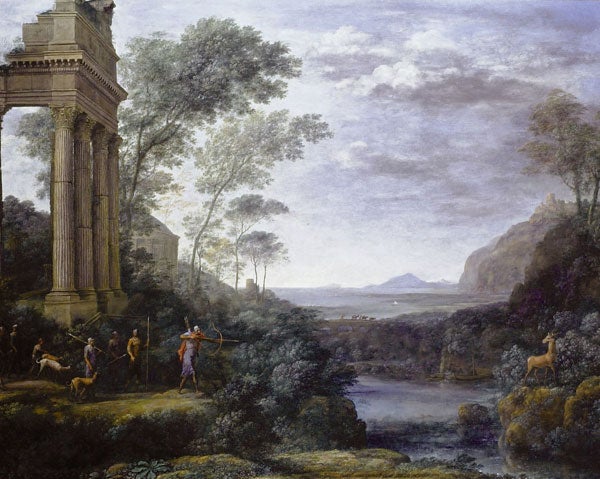Great Works: Landscape with Ascanius Shooting the Stag of Sylvia (1682), Claude Lorrain
Ashmolean Museum, Oxford

Your support helps us to tell the story
From reproductive rights to climate change to Big Tech, The Independent is on the ground when the story is developing. Whether it's investigating the financials of Elon Musk's pro-Trump PAC or producing our latest documentary, 'The A Word', which shines a light on the American women fighting for reproductive rights, we know how important it is to parse out the facts from the messaging.
At such a critical moment in US history, we need reporters on the ground. Your donation allows us to keep sending journalists to speak to both sides of the story.
The Independent is trusted by Americans across the entire political spectrum. And unlike many other quality news outlets, we choose not to lock Americans out of our reporting and analysis with paywalls. We believe quality journalism should be available to everyone, paid for by those who can afford it.
Your support makes all the difference.What's the role of the figure in landscape? Gainsborough had no doubt. It is to "fill a place (I won't say stop a gap) or create a little business, for the eye to be drawn from the trees, in order to return to them with more glee". It's strictly an extra, not a lead.
Landscape paintings are an ecological issue. They play out the relationship between nature and humanity, the earth and its inhabitants. Some painters have followed Blake's motto: "Where man is not, nature is barren." For them, the green world is a mere setting or background to human stories. But for others, like Gainsborough, the opposite holds. Trees rule. The human element is only a foil, a bit of punctuation.
And then there are landscapes where the relationship between man and land is more complicated, more dramatic. Take this picture by Claude Lorrain. Landscape with Ascanius Shooting the Stag of Sylvia has its story drawn from Roman mythology. Even its title hints at tension. Landscape and figures are at odds. The humans are neither natives nor masters of the place. They are strangers to it: invaders, desecrators.
The figures aren't simply there. This is an entrance. The hunting party arrives on the scene, from off picture, left. You need the story from Virgil to get a full idea of the impious trespass that's pictured here, the killing of a sacred beast. But Claude's scene speaks well enough for itself.
It has the air of romantic-imperial adventure, the explorers crashing through the jungle, and behind them the massive overgrown remains of an earlier native culture. They're intruders both on nature and on something that's human but older and greater than they are. Undeterred, they're bent on an outrage.
The action covers the breadth of the picture, from archer to stag, and the landscape dramatises this, putting a ravine between them. A wide bank thrusts in with the huntsmen; the narrow opposite bank backs up defensively against the frame, stops short, cutting off the quarry. Between stag and archer a vast and misty view opens to the horizon. The stage is set for the kill.
But the place remains strange, and its strangeness involves its sense of time. This is an old world, a world with traces of a remote past, shown in the broken, classical temple that frames the view. Long ago it was magnificence. Now its ruin is overgrown by the bushes that occupy most of the foreground. This is an abandoned world, a place that was once a centre of human activity but has now been reclaimed by vegetation. It isn't virgin nature on which the adventurers have stumbled. It's awesome ancient history: building, fall, return to the wild.
Yet if you imagine removing the figures and their story, the view itself could be from Claude's own time. Overgrown classical ruins are the sort of thing you would come across in 17th-century Italy, where he was working. With the figures present, though, the situation becomes more enigmatic. The scene involves a time warp, a story from antiquity being enacted among antiquity's remains.
Scale is a factor too. Relative to the columns, the figures though elongated are tiny. They make the temple look vast, and imply that it was constructed in an age of giants. It's another way that Claude's figures are made incongruous to their environment.
These humans aren't punctuation. They don't settle into their places in the picture. The eye is drawn from them and to their surroundings and back and finds on the one hand a grand and unwelcoming landscape, on the other a bunch of trespassers, aliens and no resolution between them. See it at the Ashmolean Museum, which has just reopened.
About the artist
Claude Lorrain (1600-82) was really called Claude Gelle and is known as Claude for short. Born in Lorraine, he worked as a pastry cook for a painter in Rome, and turned to art. He became the leading exponent of ideal, poetical landscape painting. Claude's nature is gracefully staged. He sets classical stories among classical ruins. His views dissolve into the distance in untraceable gradations. His mastery of morning and evening atmosphere, of subtle vapour and creeping shadows and luminous haze, astonished contemporaries and successors. His work had a great influence on both English landscape painting and English landscape gardening.
Join our commenting forum
Join thought-provoking conversations, follow other Independent readers and see their replies
Comments